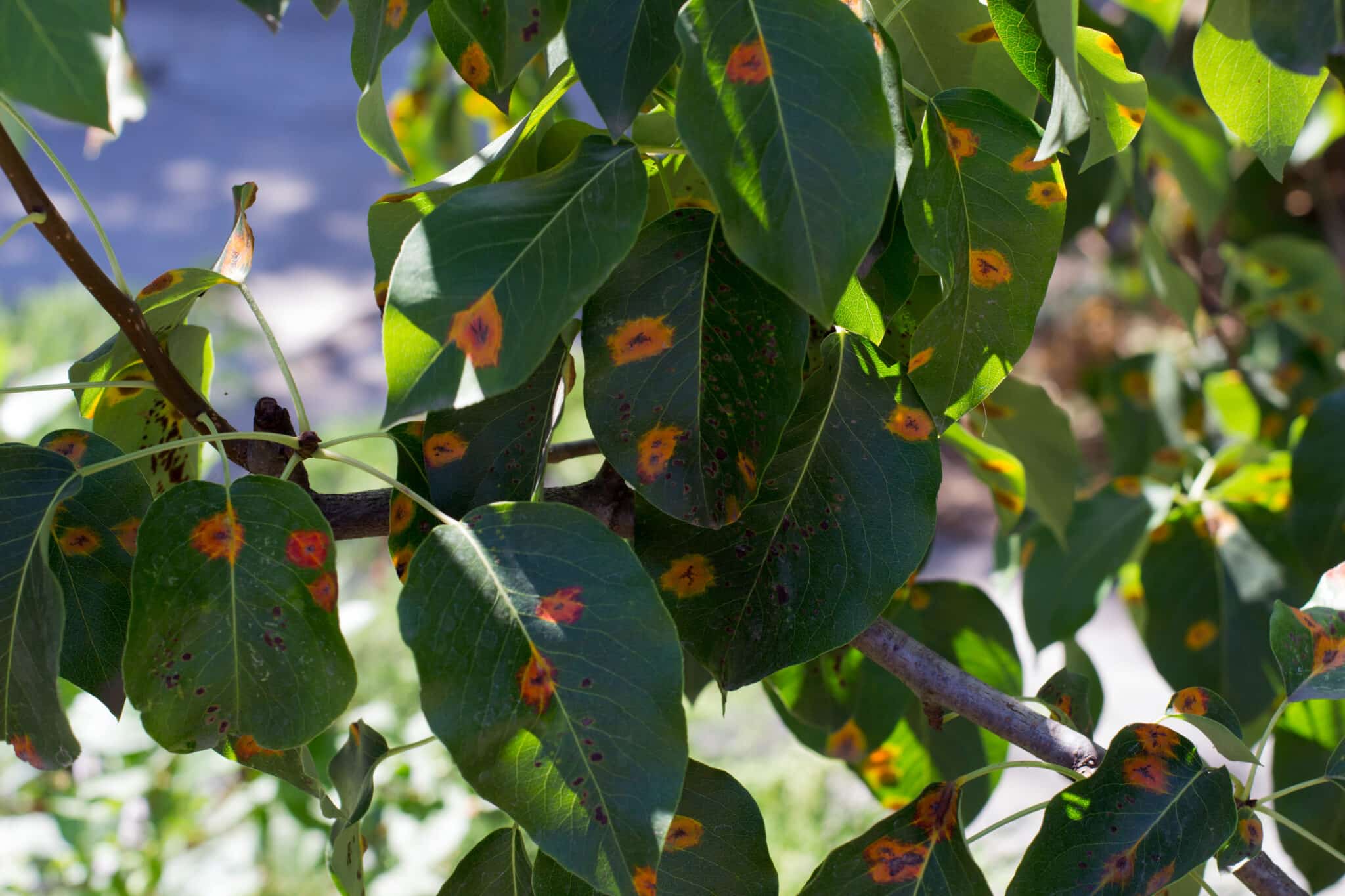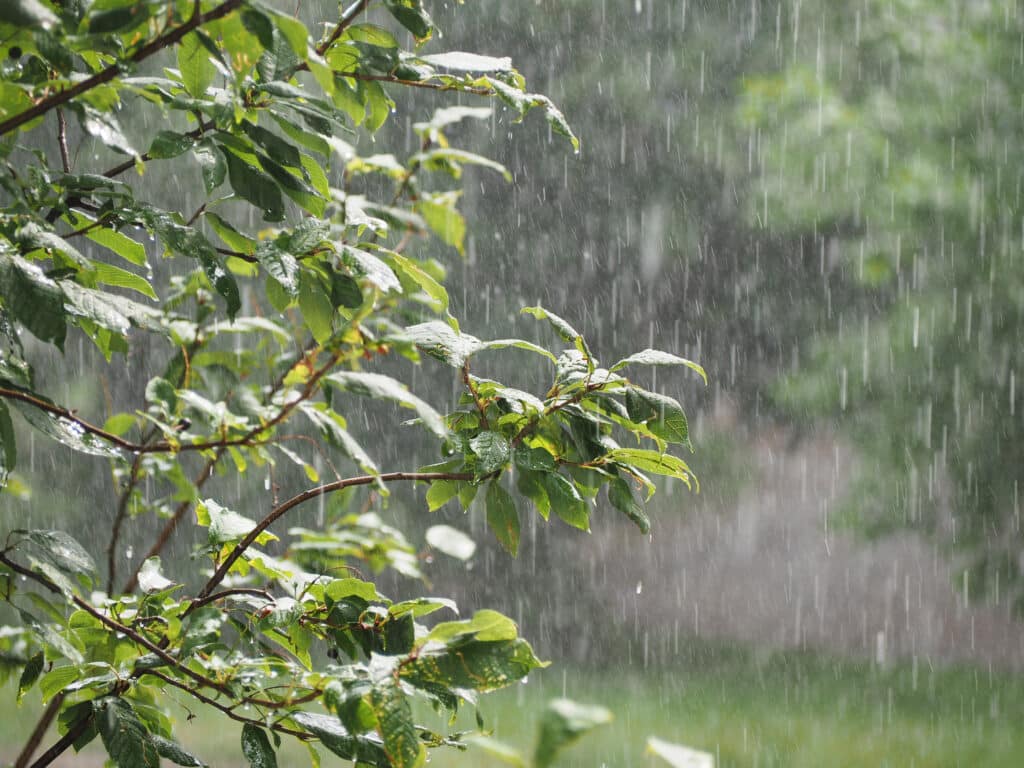Tree Stress – Does Honolulu’s wet season seem tough on your trees? While the rain is essential for keeping our tropical paradise green, too much of it can lead to tree stress.
Excess water can overwhelm their roots, leaving them gasping for oxygen and struggling to stay healthy. The result? Droopy leaves, stunted growth, and even fungal problems can quickly spread. Luckily, there are simple ways to help your trees handle the extra rain.
Table of Contents
ToggleUnderstanding Tree Stress During Honolulu’s Wet Season
What Is Tree Stress?
Tree stress occurs when environmental conditions make it difficult for a tree to grow and remain healthy. Factors like water, oxygen, and nutrient imbalances can push a tree into survival mode, disrupting its natural processes.
Over time, stress weakens the tree, making it more vulnerable to diseases, pests, and physical damage. If left unaddressed, tree stress can lead to long-term health issues or even tree death.
How the Wet Season Contributes to Tree Stress
Honolulu’s wet season brings plenty of rain, but for trees, too much water can cause significant problems. The heavy downpours may seem beneficial at first, but they often create conditions that stress trees and weaken their overall health.
- Excessive Rainfall: The frequent and heavy rains during the wet season saturate the soil, leaving it soaked for extended periods and creating waterlogged conditions.
- Oxygen Deprivation: When the soil is oversaturated, tree roots are submerged and cannot access the oxygen they need to function properly, leading to suffocation.
- Nutrient Absorption Issues: Without adequate oxygen, roots lose their ability to absorb vital nutrients from the soil, leaving the tree undernourished and weak.
- Fungal Growth: Prolonged wetness creates the perfect environment for harmful fungi like root rot and mildew to thrive, further compounding the stress on the tree.
These combined factors can severely impact a tree’s ability to grow and remain healthy during the wet season.
Why Honolulu’s Climate Makes It Unique
Honolulu’s tropical climate creates a distinct set of challenges for trees, especially during the wet season. The combination of heavy rains, warm temperatures, and high humidity amplifies stress factors like root suffocation and fungal infestations.
Native species such as koa and ʻōhiʻa are better suited to these conditions, but non-native trees often struggle to adapt. This unique environment requires careful attention to ensure that trees can thrive despite the demanding weather patterns.

Common Signs of Tree Stress in Honolulu
Yellowing Leaves
One of the first signs of tree stress during the wet season is yellowing leaves. When roots are overwatered, they struggle to absorb vital nutrients like nitrogen, leading to discoloration in the foliage.
This yellowing often starts at the tips of the leaves and spreads inward as the stress continues. Over time, the tree’s overall health can decline, making it more susceptible to pests and diseases.
Wilting or Drooping
Even with plenty of water in the soil, trees can exhibit wilting or drooping leaves during the wet season. This happens because waterlogged roots are unable to take in the oxygen needed to maintain proper hydration within the tree.
Without this balance, the tree’s system struggles to support its structure, causing leaves and branches to sag. If the issue persists, it can lead to further stress and even irreversible damage.
Fungal Growth
Fungal growth is a common issue during Honolulu’s wet season, thanks to the prolonged damp conditions. Mold, mildew, and root rot thrive in saturated soils, often spreading quickly if left unchecked.
You might notice spots or patches on leaves, trunk discoloration, or a musty smell around the base of the tree. These fungi weaken the tree, making it harder for it to recover from other stress factors.
Stunted Growth
Stressed trees often struggle to produce new leaves, flowers, or branches, leading to stunted growth. When roots can’t access enough nutrients or oxygen due to waterlogged soil, the tree prioritizes survival over growth.
This reduced growth is especially noticeable in younger trees or those already battling pests or diseases. Over time, the tree’s diminished growth can affect its overall appearance and health.
Factors That Exacerbate Tree Stress During the Wet Season
Poor Drainage
Poor drainage is a significant issue for trees in Honolulu, especially during the heavy rains of the wet season. Certain areas have clay-heavy soils that retain water, causing it to pool around tree roots.
This waterlogging deprives roots of the oxygen they need to function properly, leading to stress. Without intervention, poor drainage can quickly lead to root rot, fungal infections, and long-term health problems for the tree.
Soil Compaction
Urban environments in Honolulu often come with compacted soil, which worsens during the wet season. Compacted soil prevents water from draining properly, causing it to pool around the tree’s base.
This not only suffocates roots but also creates a breeding ground for pests and fungi. Over time, the lack of aeration in the soil can lead to weakened trees with stunted growth and higher susceptibility to stress.
Root Damage
Excessive rain and saturated soils can cause direct damage to tree roots, weakening their ability to support the tree. In waterlogged conditions, roots can suffocate, decay, or even break apart under the stress of oversaturation.
Damaged roots struggle to absorb nutrients and water efficiently, creating a cycle of stress that affects the entire tree. This damage can go unnoticed until the tree shows visible signs like yellowing leaves or drooping branches.
Pests and Diseases
Wet conditions during Honolulu’s rainy months provide the perfect environment for pests and diseases to thrive. Termites, beetles, and other pests are more active in damp conditions, targeting weakened trees as easy prey.
Similarly, fungal diseases such as root rot and mildew spread quickly in the consistently wet soil. These pests and diseases compound the stress caused by environmental factors, further weakening the tree and making recovery more difficult.
How to Alleviate Tree Stress During the Wet Season
Improve Soil Drainage
Improving soil drainage is one of the most effective ways to combat tree stress during Honolulu’s wet season. Adding organic matter like compost or sand can help loosen compacted soils, allowing water to flow away from the roots.
Creating small trenches or installing drainage pipes around the base of trees can also prevent water from pooling. By ensuring proper drainage, you give tree roots the oxygen and nutrients they need to recover and thrive.
Mulch Strategically
Mulching is a great way to protect trees, but it needs to be done carefully during the wet season. A thin layer of mulch around the base of the tree can help retain moisture without creating an over-saturated environment.
Keep the mulch a few inches away from the trunk to prevent fungi and pests from finding a home. This simple step can regulate soil moisture and protect roots from the extremes of wet season weather.
Aerate the Soil
Aerating the soil around your tree is an easy way to reduce stress caused by waterlogging. By poking small holes in the soil around the base of the tree, you improve air circulation and water drainage.
This allows roots to access the oxygen they need to function properly. Aeration is particularly helpful in urban areas where soil compaction is a common issue.
Prune Damaged Branches
Pruning damaged or weakened branches during the wet season can help a stressed tree redirect its energy. Removing dead or diseased branches lightens the load on the tree, allowing it to focus on recovery and growth.
Use clean, sharp tools to make precise cuts, and avoid pruning too heavily, as this can further stress the tree. Proper pruning also reduces the risk of fungal infections spreading during the rainy months.
Choosing the Right Trees for Honolulu’s Wet Season
Native and Hardy Species
Choosing native and hardy tree species is one of the best ways to reduce tree stress during Honolulu’s wet season. Trees like koa, ʻōhiʻa, and kukui are naturally adapted to Hawaii’s tropical environment and can handle heavy rains with ease.
These species have evolved to thrive in local conditions, making them less prone to waterlogging and disease. Planting native trees also supports local ecosystems, providing shelter and food for Honolulu’s unique wildlife.
Proper Placement
Where you plant your trees plays a big role in their ability to handle the wet season. Avoid planting trees in low-lying areas where water tends to pool, as this can lead to root suffocation and fungal growth.
Instead, choose slightly elevated spots with better drainage or consider building small berms to lift the root zone above standing water. Thoughtful placement ensures your trees have the best chance to thrive, even during the rainiest months.
Resistance to Fungal Diseases
Some tree species are more resilient to fungal infections, which are common during Honolulu’s wet season. Look for trees with natural resistance to diseases like root rot, mildew, and leaf spot.
Hardy tropical species or hybrids specifically bred for wet climates are excellent choices. This extra layer of protection helps reduce maintenance needs and keeps your trees healthier over time.
Long-Term Strategies to Support Tree Health
Regular Inspections
Conducting regular tree inspections is key to maintaining healthy trees, especially in Honolulu’s unpredictable wet season. Look for early signs of stress, such as yellowing leaves, drooping branches, or fungal growth.
Inspecting your trees every few weeks allows you to address problems before they worsen. By catching issues early, you can save time, money, and effort while ensuring your trees remain strong and vibrant year-round.
Proper Irrigation Systems
Adjusting your irrigation system during the wet season can prevent overwatering, which is a major cause of tree stress. If the rain is doing most of the work, turn down or temporarily shut off automated sprinklers.
Focus on checking soil moisture levels to ensure your trees are getting the right amount of water. Smart irrigation systems that monitor weather conditions and soil saturation are especially helpful for maintaining a balanced watering schedule.
Fertilize Sparingly
Fertilizing your trees during the wet season requires a light touch to avoid causing more harm than good. Over-fertilizing can overstimulate stressed trees, making it harder for them to recover.
Stick to a balanced, slow-release fertilizer applied sparingly to provide essential nutrients without overwhelming the tree. Timing is key—wait until the rain subsides to minimize the risk of runoff or over-saturation.
Prevent Root Damage
Protecting tree roots from damage is a long-term investment in your tree’s health. Avoid heavy machinery, excessive foot traffic, or construction activities near tree bases, especially when the soil is waterlogged.
Compacted soil or broken roots can take years to repair, so keeping the root zone safe and undisturbed is essential. Simple barriers or designated walkways can go a long way in preserving root health.
Environmental Benefits of Reducing Tree Stress
Improved Stormwater Management
Healthy trees play a significant role in managing stormwater, especially during Honolulu’s wet season. Trees with strong roots absorb excess rainwater, reducing runoff and preventing erosion.
By addressing tree stress, you’re helping the environment manage heavy rains more effectively, which is crucial in urban areas prone to flooding. A thriving tree acts like a natural sponge, protecting both the landscape and surrounding infrastructure.
Enhanced Air Quality
Trees under less stress are better at filtering pollutants from the air, a crucial benefit in busy urban areas like Honolulu. They absorb carbon dioxide, trap dust, and release clean oxygen, improving the air you breathe.
Stressed trees are less effective in these roles, so keeping them healthy ensures they continue to contribute to cleaner, fresher air. Every healthy tree makes a difference in maintaining a livable environment.
Support for Local Ecosystems
Thriving trees provide essential habitats and food sources for Honolulu’s diverse wildlife, from birds to insects. When trees are stressed, they produce fewer flowers, seeds, and leaves, disrupting the ecosystem that depends on them.
Supporting tree health during the wet season means you’re also supporting the many creatures that rely on them. Healthy trees contribute to a vibrant, balanced ecosystem unique to Hawaii’s tropical climate.
When to Consult a Professional Arborist
Persistent Signs of Stress
If your tree continues to show signs of stress—like yellowing leaves, drooping branches, or fungal growth—even after taking steps to help, it’s time to call an arborist.
These issues may indicate deeper problems with the tree’s roots or structure that require expert care. Ignoring persistent stress can lead to long-term damage, so early intervention is essential to saving your tree.
Extensive Root Damage
Roots are the foundation of a tree’s health, and extensive root damage is a serious concern. Signs like exposed roots, excessive soil pooling, or roots that appear decayed or broken may need professional attention.
An arborist can assess the extent of the damage and recommend treatments, such as improving soil conditions or reinforcing the tree’s stability, to restore its health.
Preventative Care
Even if your tree looks healthy, consulting an arborist for routine maintenance can prevent future problems. Regular pruning, soil aeration, and inspections can ensure your tree is prepared to handle the wet season.
Arborists have the tools and knowledge to address potential stressors before they become serious issues, saving you time and money in the long run.
Keep Your Trees Thriving with Mana Home Services in Honolulu!
Don’t let the wet season take a toll on your trees. At Mana Home Services, we’re experts in keeping Honolulu’s trees healthy and stress-free all year round.
From improving soil drainage to pruning and maintenance, we’ve got the skills to help your trees flourish. Contact us today and let’s ensure your trees stay strong and beautiful, rain or shine!

Frequently Asked Questions (FAQ)
How can I tell if my tree is overwatered during the wet season?
Look for signs of tree stress such as yellowing leaves, drooping branches, or soil that feels consistently soggy or emits a foul smell. Overwatering can also lead to fungal growth on the roots or trunk, which is a clear indicator of tree stress caused by too much water.
What trees are best suited for Honolulu’s wet season?
Native species like koa, ʻōhiʻa, and kukui are ideal for reducing tree stress during the wet season. These trees are naturally adapted to Hawaii’s climate and are less likely to experience tree stress from heavy rains compared to non-native species.
Can pruning help reduce tree stress during the wet season?
Yes, proper pruning is a great way to alleviate tree stress by removing damaged or weakened branches that drain the tree’s energy. Healthy pruning reduces the chance of fungal infections, which are a common contributor to tree stress in overly wet environments.
How do I improve soil drainage around my trees?
Improving soil drainage is crucial for preventing tree stress in waterlogged conditions. Adding organic materials, such as compost or sand, can help loosen compacted soils, while drainage trenches or pipes can redirect excess water. Better drainage reduces root suffocation, which is a major cause of tree stress during the wet season.
When should I call an arborist for help with tree stress?
Call an arborist if tree stress symptoms like yellowing leaves, root damage, or fungal growth persist despite your efforts. Arborists can identify hidden issues contributing to tree stress and provide solutions to restore your tree’s health.


